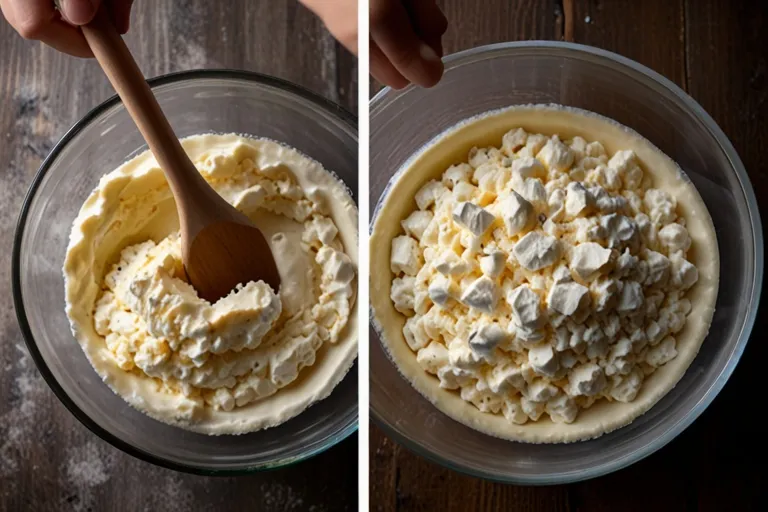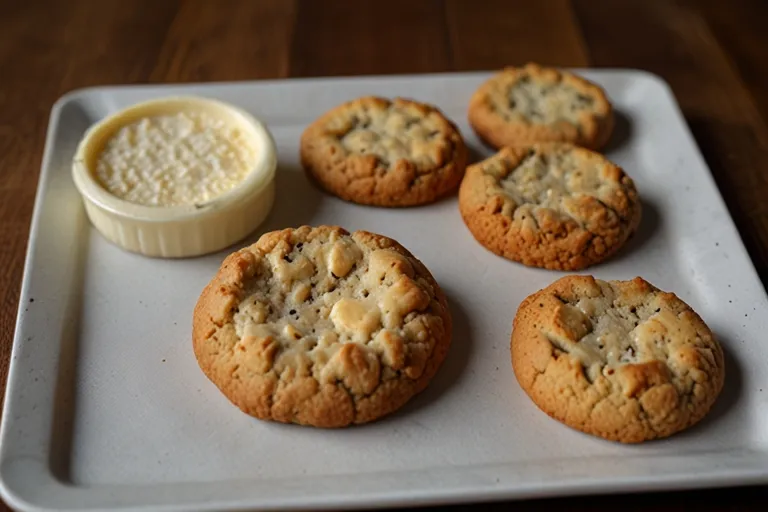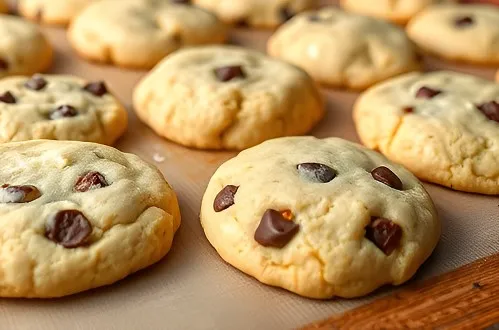Okay, let’s get baking! You know, cottage cheese cookies might sound a little, well, unexpected, but honestly, they’re about to become your new fave! This article will show you just how awesome these cookies can be. Specifically, we’ll cover everything: why they’re so good for you (and tasty!), and how to make them perfectly, every time, even if you’re not a baking whiz. Therefore, buckle up, grab your aprons, and let’s jump into the wonderful world of cottage cheese cookies!
Table of Contents
Why Cottage Cheese Cookies are a Must-Try: Health & Taste Benefits
The Unexpected Star: Discovering the Magic of Cottage Cheese in Baking
When you think of cookies, cottage cheese probably isn’t the first ingredient that pops into your head, right? However, this is where the magic truly begins! Indeed, cottage cheese in cookies isn’t bizarre; in fact, it acts as a secret weapon, giving a unique quality to these treats. It’s a bit of a game-changer, really, and I think you’ll be pleasantly surprised! It’s not at all about a cheesy taste; rather, it’s about creating that perfect tender texture and adding a nutritional punch you don’t typically expect in a cookie. Ultimately, it transforms the ordinary into something truly special. These cookies are special, indeed.
Health Benefits of Cottage Cheese: More Than Just Protein
Now, let’s talk health for a sec, but not in a boring way, I promise! Cottage cheese isn’t just for dieters (though, it absolutely can be!). It packs a lot more than you might initially think!
Low-Fat, High-Protein Option
First of all, it’s a fantastic source of protein. Protein, as we know, keeps you feeling full and satisfied. As a result, these cookies can help you stay full longer than many others. Plus, it’s usually lower in fat compared to many other cookie ingredients. Consequently, this makes it a healthier choice overall. Therefore, this makes your cookie a much better option if you’re watching what you eat. It’s a win-win situation!
Source of Essential Nutrients
Besides that, cottage cheese also has other beneficial nutrients. It has calcium, which as you might know is vital for strong bones, and some essential vitamins. Thus, it’s like sneaking in a little bit of healthy goodness into your treat. And let’s be honest, it’s always a great idea. This, in turn, makes it a smarter choice than your average cookie, offering more than just empty calories.
Taste and Texture: How Cottage Cheese Transforms Cookies
Now, for the taste test, which, to be honest, is what most of us care about, right?! Ultimately, taste matters most!
Creating Moist and Tender Cookies
Indeed, the real game-changer with cottage cheese is the incredibly moist and soft texture it gives to the cookies. It isn’t about a strong cheesy flavor; rather, it gives your cookies a wonderfully tender bite, almost melting in your mouth – like a little cloud of deliciousness. You simply won’t find this sort of texture in a standard cookie! The cottage cheese, in fact, ensures soft, supple cookies, rather than dry, crumbly ones.
Mild Flavor that Adapts to Different Flavors
And here’s the best part: cottage cheese has a remarkably mild flavor! Consequently, it doesn’t overpower the other flavors. Instead, it hangs out subtly in the background and plays very well with other ingredients, like chocolate chips, nuts, or vanilla. In essence, it’s a blank canvas. In fact, it becomes a delicious cottage cheese cookie, letting each ingredient truly shine. It’s the perfect base for any flavor combination.
Classic Cottage Cheese Cookie Recipe: A Step-by-Step Guide

Gathering Your Ingredients: Essential Components for Cottage Cheese Cookies
First things first, you need to assemble your team of ingredients. As you know, it’s the usual, but with a quirky, cheesy twist! Before you start, make sure you have everything ready; this will definitely make the process easier.
Listing the Basic Dry and Wet Ingredients
Specifically, you’ll need all-purpose flour (though other flours can work for dietary restrictions!), sugar (white or brown, it’s your choice!), baking powder (for those light, fluffy cookies), and a pinch of salt (to perfectly balance sweetness). For the wet ingredients, grab some unsalted butter (make sure it’s softened!), a fresh egg, and, of course, that star ingredient, cottage cheese! It’s really like a simple puzzle; you just need to fit the right pieces together. Remember, you should measure each ingredient carefully.
Notes on Different Types of Cottage Cheese
Now, here’s an important tip: full-fat cottage cheese will provide you with a richer, more moist cookie, while low-fat works equally well if you’re trying to reduce fat. Also, when you’re choosing your cottage cheese, make sure to opt for the small curd variety for a smoother batter. That way, your cookies will bake perfectly, with a delightfully soft and even texture. This, in fact, is key to achieving the ideal result.
The Mixing Process: Combining Ingredients Perfectly
Next up, we need to combine all of these ingredients together. While the mixing process is straightforward, you still need to follow these crucial tips to get the very best results!
Tips for Smooth Consistency
First, begin by thoroughly mixing the wet ingredients together until they are completely combined. Then, slowly start to add in the dry ingredients, mixing them bit by bit until a nice dough starts to form. You want the dough to be soft, supple, and not too sticky. However, avoid overmixing; that’s a mistake many people often make. Overmixing can lead to a tough cookie, which is definitely not what we’re aiming for. So, mix until just combined!
Importance of Properly Incorporating Cottage Cheese
Crucially, make sure the cottage cheese is fully incorporated into the dough. Otherwise, you might find clumps of cottage cheese in your cookies, which we want to avoid. Therefore, achieving a smooth batter is key to ensuring that your cottage cheese cookies turn out just right, with an even texture in every single bite. After all, a smooth batter is the key to smooth cookies!
Baking Instructions: Achieving the Ideal Texture and Color
Alright, now it’s finally time to heat things up – literally! And now, your baking skills will really come into play!
Optimal Baking Temperatures and Times
Bake these delicious goodies at 375°F (190°C) for approximately 10-12 minutes. However, it’s essential that you keep a close watch on them because every oven is slightly different and has its own quirks! You want them to be slightly golden around the edges but still soft in the middle – that’s the sure sign that they’re done to perfection! Ultimately, it’s all about finding that sweet spot!
Tips for Preventing Over-browning
To keep them from getting too dark and crispy, position the baking sheet on the middle rack of your oven. Also, it might be a good idea to reduce the baking time by a minute or two if your oven has a tendency to run hot. That way, your cookies will be perfectly baked without getting burnt! As we all know, nobody likes a burnt cookie, right?!
Cooling and Serving: Letting the Cottage Cheese Cookies Set
Patience is a virtue, young grasshopper; and also, patience is definitely needed here! Therefore, you will need to wait for the cookies to cool down before you can fully enjoy them.
Importance of Proper Cooling Time
So, let the cookies cool on the baking sheet for a few minutes before carefully transferring them to a wire rack where they can cool down completely. This allows them to set properly and avoid falling apart, so it’s definitely a step you don’t want to miss. Allowing the cookies to cool will, in fact, help set the final texture and keep their structure.
Serving Suggestions and Storage Tips
These cottage cheese cookies are absolutely fantastic by themselves, or, if you are craving some extra comfort, you can enjoy them with a glass of milk! To keep them soft and scrumptious for up to 3 days, store them in an airtight container at room temperature – assuming, of course, that they last that long!. Moreover, you can also freeze them for up to a month, allowing you to have these delicious cookies on hand whenever you get that cookie craving! And also, they would be great to have on hand when you would make a BBQ chicken flatbread to eat together!
Variations & Twists: Exploring Different Types of Cottage Cheese Cookies

Sweet Additions: Enhancing the Flavor with Fruits and Spices
Okay, so you’ve finally mastered the basic cottage cheese cookie! Now, it’s high time to let your creativity run wild and experiment with a wide array of exciting flavors! After all, there are many things you can do to personalize them and truly make them your own!
Adding Berries, Chocolate, and Nuts
For instance, try folding in some chocolate chips (milk chocolate, dark chocolate, or even white chocolate – you choose!), some dried cranberries (or other dried fruits), or some chopped nuts (such as walnuts, pecans, or almonds). This will, for sure, give your cookies added texture and a wonderful burst of flavour with every bite. Also, you can even mix different kinds of chocolate or nuts!
Using Cinnamon, Vanilla and Other Spices
Similarly, a touch of cinnamon or vanilla extract (or almond or lemon extract) will do wonders for the smell and taste of your cookies. And also, a little ground nutmeg, cardamom, or ginger can give your cookies a lovely warm and comforting flavour. Indeed, experimenting with different spices can completely transform your cottage cheese cookies, taking them to a whole new level of deliciousness. In essence, it’s a simple way to get creative with your baking!
Savory Cottage Cheese Cookie Options
Who says that cookies should always be sweet? Let’s step away from the usual and think outside the box! You might very well be surprised at how delicious savoury cookies can be!
Incorporating Herbs and Cheese
Now, try to add some fresh herbs such as rosemary, thyme, or chives (finely chopped) along with some grated Parmesan cheese for a savory twist that might seem unconventional but tastes absolutely amazing! This results in a savory treat with a unique flavour that is certainly worth exploring. The salty cheese, along with the fresh herbs and the subtle flavour of the cottage cheese, makes for a wonderfully delicious cookie.
Creating a Savory Treat for Appetizers
In fact, these savory cottage cheese cookies are a fantastic alternative for appetizers, or if you are serving soup. Also, they are a great way to have something different than the usual crackers or bread. Consequently, they are bound to become a hit!
Gluten-Free Cottage Cheese Cookies: Adapting the Recipe
For those who are on a gluten-free diet, well, we have got you covered with this simple adjustment!
Flour Substitutions for Gluten-Free Baking
Therefore, try to swap out the regular all-purpose flour for almond flour, oat flour, or a gluten-free blend of flours. This might, in fact, change the texture of your cookies slightly, but I can assure you that they will still be incredibly delicious. When baking gluten-free cookies, it’s often about experimenting until you find what works best for you!
How to Achieve the Same Texture without Gluten
Remember to add a little xanthan gum to help bind things together, which is often crucial for gluten-free baking. This, in fact, is what helps give gluten-free baked goods their desired texture, since gluten usually provides that binding, but is not present in gluten-free flours. Indeed, this step will be a game-changer!
Substituting Dairy Cottage Cheese
Specifically, try substituting the dairy cottage cheese with vegan cream cheese or mashed silken tofu. These substitutes will, no doubt, give you a texture that is very similar to the original recipe, which is a great way to achieve those perfect cookies while keeping them dairy-free. Indeed, these alternatives are great to provide that same soft and moist texture.
Achieving a similar consistency and flavor profile
Also, to achieve a bit of that signature tang that you would get from cottage cheese, you can add a touch of lemon juice. With a few simple tweaks, you can create vegan cottage cheese cookies that are just as delicious and flavourful. Therefore, they are bound to be a hit!
Troubleshooting Common Issues: Ensuring Perfect Cottage Cheese Cookies Every Time

Common Baking Problems with Cottage Cheese
Let’s face it; sometimes, cookies just don’t want to cooperate.
Why My Cookies are Too Runny or Flat
If your cookies spread out all over the baking sheet, it’s likely that your dough is just too wet. This can happen, for example, if you didn’t drain the cottage cheese well enough, or if your butter was too melted. It’s a pretty common issue, so don’t worry!
Addressing Issues of Crumbling or Dry Cookies
On the other hand, if your cookies are crumbly, that usually means your dough is too dry. This can happen if, for example, you used too much flour, or if you used the wrong kind of cottage cheese. Therefore, you should add a bit more of the wet ingredients to balance it out.
Tips to Adjusting the Recipe
Don’t fret; there are, in fact, some easy fixes!
How to Adjust for Different Cottage Cheese Textures
If your cottage cheese is really very wet, try draining it in a sieve for a bit before using it. Also, you might want to reduce the amount of butter if your cheese is very moist. This, in turn, will help the dough to reach the right consistency.
Correcting Ingredient Ratio Problems
If your dough is too wet, add a little more flour, one tablespoon at a time, until the consistency is just right. And if it’s too dry, add a tiny bit of milk or melted butter. After all, it’s all about finding that perfect balance.
Achieving the Right Texture and Consistency
Let’s get this right; perfect cookies are certainly within reach!
The Role of Moisture in the Dough
Indeed, moisture is super important for making those perfectly soft cookies. Therefore, if you use a drier cottage cheese, you might need to add a little more wet ingredient to really help with the texture. Also, it helps if the ingredients are at room temperature!
Cottage Cheese Cookies for Special Diets & Preferences
Low-Carb and Keto-Friendly Cottage Cheese Cookie Options
Now, want to enjoy delicious cottage cheese cookies while keeping a watchful eye on your carb intake? No problem!
Substituting Sugar with Artificial Sweeteners
Use sugar substitutes like stevia, erythritol, or monk fruit instead of regular sugar. This way, you can enjoy a sweet treat without all the added sugar.
Using Low-Carb Flours and Binding Agents
For example, try using almond flour or coconut flour instead of all-purpose flour, and use a binding agent like psyllium husk. This will create a low-carb cookie that perfectly fits your dietary needs.
Making Cottage Cheese Cookies Suitable for Children
As we know, kids love cookies, and cottage cheese cookies can be made super fun for them, too!
Kid-Friendly Flavor Combinations
Add some sprinkles, mini chocolate chips, or chopped dried fruit that kids enjoy to make your cookies colourful and very appealing. This way, it will definitely make baking and eating more fun!
Easy to Handle and Serve Forms
Make them into smaller, bite-sized cookies for easy handling, or cut them with fun cookie cutters. These will be, without a doubt, extra appealing to children!
Allergy Considerations and Substitutions
Now, let’s make sure everyone can enjoy these cookies!
Alternatives for Gluten and Dairy Allergies
Use gluten-free flour blends and dairy-free substitutes like vegan butter and cream cheese for those with dietary restrictions. Ultimately, baking should be fun for everyone! You can check out our Gluten-Free Apple Pancakes recipe for another allergy-friendly recipe. Or, alternatively, see our recipe section for more amazing recipes.
Tips for Making the Best Cottage Cheese Cookies
The Importance of Fresh Ingredients: Quality Matters
First up, using really good ingredients makes a big difference, you know? For instance, fresh eggs, good quality butter, quality flour, and most importantly, fresh cottage cheese. This forms the foundation for your amazing cookies. Indeed, you can taste the difference!
Proper Measuring Techniques for Success
Now, baking isn’t just about eyeballing it! Using measuring cups and spoons accurately is super important, especially when you are working with cottage cheese. This ensures that your wet-to-dry ratios are correct and consistent each and every single time!
Preheating the Oven and Correct Baking Time
Always preheat your oven! This ensures, for sure, even cooking. Also, don’t overbake your cookies; they’ll just get hard and dry! Bake them until they are lightly golden around the edges, and still, soft in the middle. Truly, it’s the very best way to bake them!
Techniques for Storing Baked Cookies to maintain freshness
To keep your cookies soft and delicious for a few days, store them in an airtight container at room temperature. If you’re planning on freezing them, wrap them well in plastic wrap before putting them in the freezer. And also, if you’re going to eat them the very next day, pop them in the microwave for 10 seconds to get that fresh-out-of-the-oven texture!
Cottage Cheese Cookie FAQs: Addressing Your Queries
Okay, let’s answer some of those burning questions you might very well have about cottage cheese cookies. You know, the kind of things that could be keeping you up at night!
Can I Use Full-Fat or Reduced-Fat Cottage Cheese for this recipe?
Yep! Both work just fine, but it’s worth remembering that full-fat will give you a richer, more moist cookie. However, reduced-fat is just as good if you’re watching your fat intake.
How Do I prevent the cookies from becoming soggy?
Most importantly, make sure you drain your cottage cheese well, and also, don’t overbake your cookies. Also, ensure that your butter isn’t too melted before you start the recipe!
Can I substitute other types of cheeses?
While cottage cheese is key, you can use something like ricotta cheese for a similar texture. However, the flavor profile might change significantly. Also, you should be careful, as other cheeses might be too strong or too salty!
How long will cottage cheese cookies last?
They’ll stay good for about 3 days at room temperature if stored in an airtight container. However, if you are not planning on eating them in a few days, then it’s best to store them in the freezer.
Can I freeze cottage cheese cookie dough?
Yes, you can! Simply portion it out, and then freeze it in freezer bags. Then, when you want some fresh cottage cheese cookies, just take it out, let it defrost for a bit, and bake it. It’s perfect, for those moments you need a quick cookie fix!

